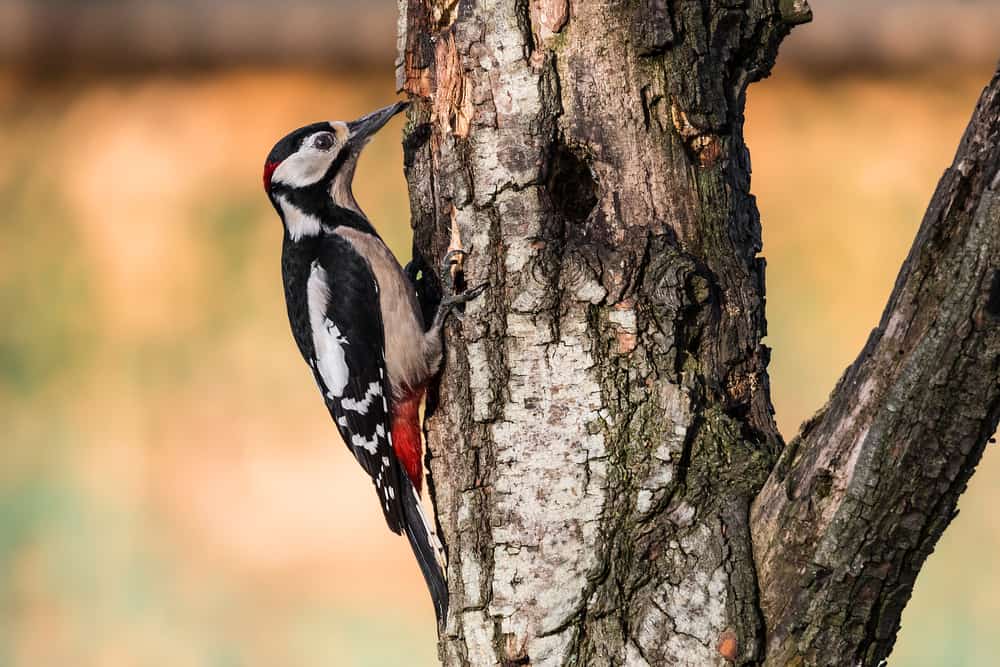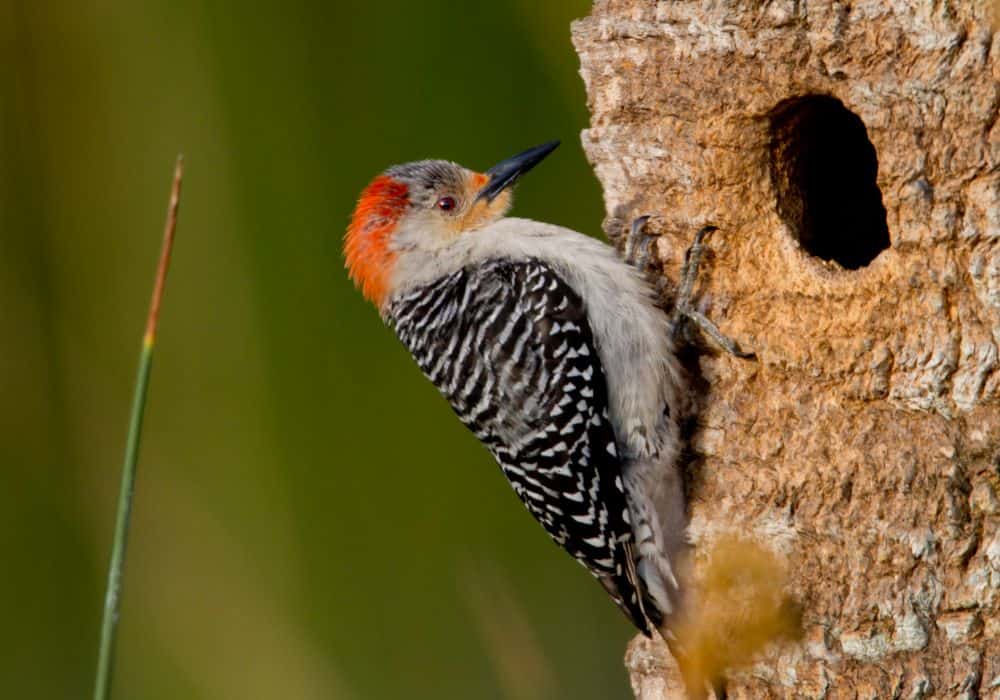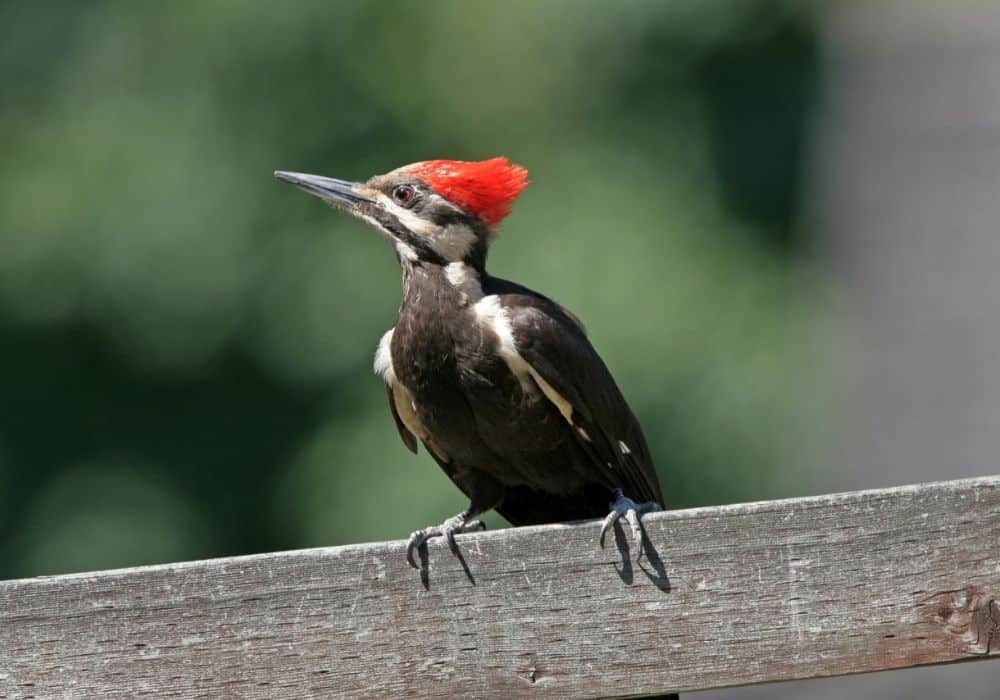Though they may seem small and unassuming, woodpeckers are powerhouse birds that play a vital role in our ecosystems.
These fascinating creatures have many unique adaptations that allow them to peck into tree bark to find food. But just what do woodpeckers eat? Keep reading to find out!
Interesting Facts about woodpeckers
Woodpeckers are a type of bird known for their wood pecking habits. According to Britannica, the woodpecker belongs to the family Picidae. There are approximately 200 different species of woodpeckers, although the most iconic is the Pileated Woodpecker.
Woodpeckers range in size from around 7.5 cm to more than 50 cm in length and around 8.5 grams to 550 grams in weight. They are found worldwide, leaving the regions of Australia, New Guinea, Madagascar, New Zealand, and some other extreme polar regions.
Among the residential areas, woodpeckers are abundant in South America and Southeast Asia. Some temperate-zone woodpecker species are migratory, such as the yellow-bellied sapsucker and the flicker.
The woodpeckers in the north spend wintertime in trees like oak, maple, and ash. But down south, it’s different; these birds hole up inside pine trees to stay warm during cold months when food is scarce.
Woodpeckers have specific characteristic behaviors. They communicate by drumming with their beaks, producing a reverberatory sound that is audible up to a certain distance.
They mainly make sounds in the spring and remain quiet in all the other seasons. They tend to stay alone or may travel in pairs. Woodpeckers are also among the most innovative and intelligent birds in the world.
Sometimes woodpeckers may conflict with humans by making holes in buildings or feeding on fruit crops but are usually helpful to humans as they remove insect pests on trees when they bore their holes to provide.
Woodpeckers prefer dead trees, as stated by Bird Feeder Hub. Dead trees are softer than live trees, making it easier for the woodpecker to get their food and burrow into the tree, making a cavity for its nest.
How Do Woodpeckers Reproduce?
They use distinctive calls to attract the opposite sex during the mating season, which lasts from early winter until spring. Usually, most woodpecker species are monogamous and form lifelong bonds with their partners.
However, some exceptions exist, such as the Acorn Woodpeckers, where the females mate with several males during the mating season. There are also the Willow Bird Peckers who separate from their mate after the breeding season.
The breeding pair work together to build the nest, incubate the eggs, and raise their young ones. The eggs are incubated for 11-14 days, and once the eggs hatch, both parents raise them until they are old enough to survive on their own.
What Is The Myth About Woodpeckers?
There have been many myths associated with woodpeckers. The prominent comes from Roman mythology, where a woodpecker named Picus is sacred to the god Mars. It was an agricultural deity and worshipped primarily.
In many ancient cultures, woodpeckers are signified as wishes, luck, prosperity, and spiritual healing, whereas in other cultures, they symbolize hard work, perseverance, strength, and determination. In many ancient mythologies, dreaming about a woodpecker is associated with magic.
In the Native American tribal community, the woodpecker is referred to as the “humankind protector,” as belief says that a woodpecker’s nest is an incredible example of guarding humankind’s spirituality.
What Do Woodpeckers Eat?
The woodpecker family is quite flexible about its diet. It may be both highly omnivorous and opportunistic. Woodpeckers alter their diet with changing seasons to meet their nutritional needs.
Woodpeckers feast upon the sweet tree sap when food sources are not as readily available in the spring.
Popular food choices in the summer include wood-boring insects such as carpenter ants, termites, and some beetles. These insects provide high levels of protein for birds that are breeding.
In addition to tree sap and wood boring insects, woodpeckers enjoy berries like strawberries, blueberries, and other fruits like cherries and oranges. As a result, they play an important role in dispersing seeds and keeping the forest ecosystem healthy.
In the fall and winter, these birds take advantage of the natural harvests and complete their diet by feeding upon nuts and seeds.
Woodpeckers also feed upon insects such as caterpillars and spiders living under the bark or in the woods. These birds usually store live grasshoppers, larvae, and acorns and carry them from place to place when they travel so they can retrieve and eat them during the winter season.
What Is A Woodpecker’s Favorite Food?
Like many other creatures such as squirrels and chickadees, the woodpeckers are also very fond of eating suet cakes made of nuts, insects, or fruit blends.
According to Birds&Blossoms, sunflower and black oil sunflower seeds are some of the woodpeckers’ favorite foods, along with acorns, beech nuts, peanuts, and pecans.
How Do Woodpeckers Reach Their Food?
Woodpeckers have long bills and strong beaks to help them get to their food. They are incredible hunters with a sense of smell so powerful that they can locate high concentrations of formic acid (a fluid produced by their prey) from miles away.
They tap on portions of trees and listen for movement beneath the bark or within the wood, then bore into whatever is there with their beaks if they detect any! Then, they use their long, sticky tongues to retrieve their insect grub.
What Are The Predators Of Woodpeckers?
Woodpeckers are essential to many ecosystems, providing valuable services such as insect control and tree fertilization. However, these birds are also subject to predation from various animals.
Snakes, grackles, and owls often raid the nests of woodpeckers in search of eggs or young birds. In addition, feral cats, bobcats, foxes, and coyotes, will occasionally prey on adult woodpeckers.
Birds of prey such as hawks, eagles, and falcons also threaten the beautiful birds.
While most predators only target a small number of woodpeckers each year, this ongoing predation can significantly impact local populations.
As a result, it is essential to be aware of the predators of woodpeckers to help protect these valuable birds.
Woodpeckers are protected under the Federal Migratory Bird Treaty Act, so humans are not usually a threat.
What Attracts Woodpeckers To Your Yard?
Woodpeckers are an essential part of the ecosystem, helping to aerate the soil and control pests. In addition, their striking plumage can add a splash of color to your yard. If you’re hoping to attract woodpeckers to your property, you can do a few things.
Suet cakes are a favorite food of woodpeckers, so placing a suet feeder in your yard is an excellent way to attract them. You can also provide a source of fresh water by putting out a birdbath.
If you want to get creative, smear some peanut butter on a tree, or create your bird feeder using peanut butter and seeds. This is a great craft you can do with kids, and it’s even fun for adults!
Woodpeckers are also attracted to dead trees and logs, so if you have any on your property, leave them be.
Following these simple tips will soon have woodpeckers visiting your yard regularly.
How To Attract Big Woodpeckers To Your Yard?
Suppose you are a backyard birder and want to witness the beauty of big woodpeckers in your backyard.
The pileated woodpecker is the largest in North America and a truly stunning bird. These birds are primarily black, with white stripes and a prominent red crest on their wings. They are also timid and can be challenging to spot in the wild.
However, you still can do certain things to attract pileated woodpeckers to your yard. First, create a natural habitat by planting native trees and shrubs.
Pileated woodpeckers prefer woods with dense foliage, so they are more likely to visit yards that offer this habitat. You can also try creating a birdhouse or nesting box explicitly designed for pileated woodpeckers.
The birdhouse should have a large hole, at least four inches in diameter. By taking these steps, you can give yourself a better chance of spotting these beautiful birds in your backyard.
Final Words
Woodpeckers are fascinating creatures with many unique adaptations that allow them to thrive in their arboreal habitats. By understanding more about these birds, we can appreciate the intricate design of nature and the importance of preserving our woodlands.
Did you find this article helpful? Let us know in the comments below!
Key Takeaways
- Woodpeckers’ favorite foods are suet cakes, sunflower seeds, berries such as strawberries and blueberries, fruits such as oranges and cherries, peanuts, pecans, and insects.
- Placing their foods such as suet feeders, making a water source available, or a perching spot and creating a bird-friendly environment could attract these birds to the yard.
- Snakes, owls, feral cats, bobcats, foxes, hawks, eagles, and falcons threaten woodpeckers and their nests.


